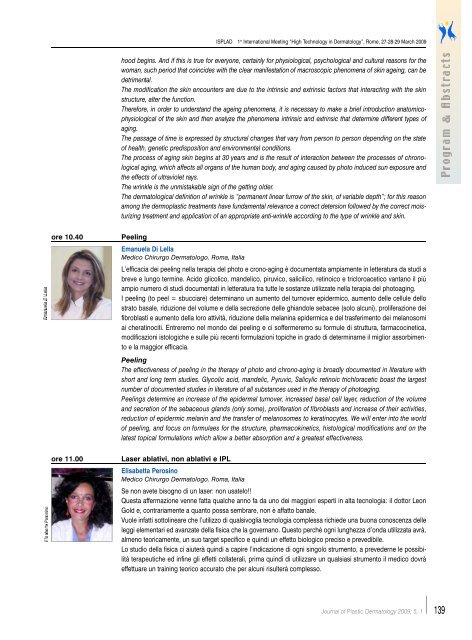Vol. 5, n. 1, January-March 2009 1th International ... - Salute per tutti
Vol. 5, n. 1, January-March 2009 1th International ... - Salute per tutti
Vol. 5, n. 1, January-March 2009 1th International ... - Salute per tutti
Create successful ePaper yourself
Turn your PDF publications into a flip-book with our unique Google optimized e-Paper software.
ore 10.40 Peeling<br />
hood begins. And if this is true for everyone, certainly for physiological, psychological and cultural reasons for the<br />
woman, such <strong>per</strong>iod that coincides with the clear manifestation of macroscopic phenomena of skin ageing, can be<br />
detrimental.<br />
The modification the skin encounters are due to the intrinsic and extrinsic factors that interacting with the skin<br />
structure, alter the function.<br />
Therefore, in order to understand the ageing phenomena, it is necessary to make a brief introduction anatomicophysiological<br />
of the skin and then analyze the phenomena intrinsic and extrinsic that determine different types of<br />
aging.<br />
The passage of time is expressed by structural changes that vary from <strong>per</strong>son to <strong>per</strong>son depending on the state<br />
of health, genetic predisposition and environmental conditions.<br />
The process of aging skin begins at 30 years and is the result of interaction between the processes of chronological<br />
aging, which affects all organs of the human body, and aging caused by photo induced sun exposure and<br />
the effects of ultraviolet rays.<br />
The wrinkle is the unmistakable sign of the getting older.<br />
The dermatological definition of wrinkle is “<strong>per</strong>manent linear furrow of the skin, of variable depth”; for this reason<br />
among the dermoplastic treatments have fundamental relevance a correct detersion followed by the correct moisturizing<br />
treatment and application of an appropriate anti-wrinkle according to the type of wrinkle and skin.<br />
Emanuela Di Lella<br />
Medico Chirurgo Dermatologo. Roma, Italia<br />
L’efficacia dei peeling nella terapia del photo e crono-aging è documentata ampiamente in letteratura da studi a<br />
breve e lungo termine. Acido glicolico, mandelico, piruvico, salicilico, retinoico e tricloroacetico vantano il più<br />
ampio numero di studi documentati in letteratura tra tutte le sostanze utilizzate nella terapia del photoaging.<br />
I peeling (to peel = sbucciare) determinano un aumento del turnover epidermico, aumento delle cellule dello<br />
strato basale, riduzione del volume e della secrezione delle ghiandole sebacee (solo alcuni), proliferazione dei<br />
fibroblasti e aumento della loro attività, riduzione della melanina epidermica e del trasferimento dei melanosomi<br />
ai cheratinociti. Entreremo nel mondo dei peeling e ci soffermeremo su formule di struttura, farmacocinetica,<br />
modificazioni istologiche e sulle più recenti formulazioni topiche in grado di determinarne il miglior assorbimento<br />
e la maggior efficacia.<br />
Peeling<br />
The effectiveness of peeling in the therapy of photo and chrono-aging is broadly documented in literature with<br />
short and long term studies. Glycolic acid, mandelic, Pyruvic, Salicylic retinoic trichloracetic boast the largest<br />
number of documented studies in literature of all substances used in the therapy of photoaging.<br />
Peelings determine an increase of the epidermal turnover, increased basal cell layer, reduction of the volume<br />
and secretion of the sebaceous glands (only some), proliferation of fibroblasts and increase of their activities,<br />
reduction of epidermic melanin and the transfer of melanosomes to keratinocytes. We will enter into the world<br />
of peeling, and focus on formulaes for the structure, pharmacokinetics, histological modifications and on the<br />
latest topical formulations which allow a better absorption and a greatest effectiveness.<br />
ore 11.00 Laser ablativi, non ablativi e IPL<br />
Elisabetta Perosino<br />
Medico Chirurgo Dermatologo. Roma, Italia<br />
ISPLAD 1 st <strong>International</strong> Meeting “High Technology in Dermatology”, Rome, 27-28-29 <strong>March</strong> <strong>2009</strong><br />
Se non avete bisogno di un laser: non usatelo!!<br />
Questa affermazione venne fatta qualche anno fa da uno dei maggiori es<strong>per</strong>ti in alta tecnologia: il dottor Leon<br />
Gold e, contrariamente a quanto possa sembrare, non è affatto banale.<br />
Vuole infatti sottolineare che l’utilizzo di qualsivoglia tecnologia complessa richiede una buona conoscenza delle<br />
leggi elementari ed avanzate della fisica che la governano. Questo <strong>per</strong>ché ogni lunghezza d’onda utilizzata avrà,<br />
almeno teoricamente, un suo target specifico e quindi un effetto biologico preciso e prevedibile.<br />
Lo studio della fisica ci aiuterà quindi a capire l’indicazione di ogni singolo strumento, a prevederne le possibilità<br />
terapeutiche ed infine gli effetti collaterali, prima quindi di utilizzare un qualsiasi strumento il medico dovrà<br />
effettuare un training teorico accurato che <strong>per</strong> alcuni risulterà complesso.<br />
Journal of Plastic Dermatology <strong>2009</strong>; 5, 1<br />
139

















